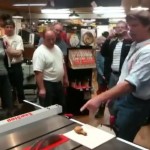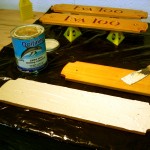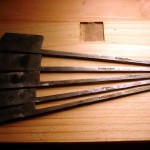If you are a woodworker, and have not been asleep, you’ve heard that the Consumer Product Safety Commission (CPSC) appears eager to mandate all table saws include flesh sensing technology? Yes, their pre-rulemaking comment period is open right now and they need to hear from you.
 The issue is reducing injuries due to table saw accidents. Admirable! It’s certainly a good thing to do and there’s no question that saving fingers and hands is always preferable to any alternative. Yet, how?
The issue is reducing injuries due to table saw accidents. Admirable! It’s certainly a good thing to do and there’s no question that saving fingers and hands is always preferable to any alternative. Yet, how?
If you’re an avid woodworker, you’ve probably heard of the brilliant SawStop technology. Maybe you have seen videos of how it works. It is amazing!
You might also have heard of “Osorio versus One World Technologies,” a court case in which a person was seriously injured using a table saw. They have both come together in an interesting way, and now the CPSC is riding in on a white horse to save us all from ourselves.
The whole story is many thousands of pages long, so I will offer only the barest of facts as I know them. Yes, I have my own opinions and, yes, you will find the information I present biased. There’s a big pile of links at the bottom of this posting.
SawStop
Let’s take the SawStop part first. Here are only a few of the things we know:
- Stephen Gass invented the SawStop technology in 1999. (…in his barn? …on a dark and stormy night? )
- Gass, being a patent attorney, surrounded his invention with patents (counts vary from 50 to 83!). One imagines he expects a wealth of royalty payments to flow from them, or maybe even a wealth of infringement awards.
- Gass attempted to license his technology to most of the big name tool manufacturers, including One World Technologies (parent of Ryobi) in October 2000. That almost worked with one, but ended up failing with all. It even ended up ticking off the Power Tools Institute, and organization to which most of the big tool manufacturers belong. (Not enough time / space here to go into all the reasons. They’re not hard to find.)
- Gass originally asked Ryobi for a 3% royalty which would increase to 8% if a majority of other manufacturers also used the technology. (Don’t royalties based on volume usually discount as volume increases?)
- Failing to interest other manufacturers, Gass launched his own tool manufacturing company bring us the SawStop line of products: Headquarters in Oregon, Manufacturing in Taiwan, 2005.These actions cause me no complaints, except maybe he’s a little over the top with the number of patents. But hey, when you’re a patent attorney… He has a great idea and he’s trying to make the most of it in the way that our American system affords: limited protection for inventors and a market system in which to sink or swim. Personally, I wish them every success in the market. (my meaning of market = open, unconstrained)
- Gass petitioned Congress to create laws favoring his technology. The legislation was labeled “Temporary Suspension of Duty on Tilting Arbor Table Saws…” It was an attempt to temporarily suspend duty on certain Taiwanese made saws. There were two bills with similar titles, differentiated by power capacities, 1865-2611 watts and 3357-4103 watts, and “with contact detection and reaction systems.” Do you think these might match the load usage of SawStop saws, that there’s an attempt to craft legislation that benefits only one firm, that a little bit of money well spent won’t hurt?
HR 4782 and HR 4783 were both proposed by Congressman Wu from Oregon in 2007-2008. [SawStop is headquartered in Oregon. Who knew?!] I have not determined if either passed. The bureaucratic swamp is very deep and murky.
- Spanning much of the time described above, Gass petitioned the CPSC in to “require performance standards for a system to reduce or prevent injuries from contact with the blade of a table saw.” That petition was in 2003, was reviewed in due time, started its way through the CPSC process and was shelved when the CPSC “lost their quorum” in 2006. {Bureaucracy note: The CPSC needs a full slate of commissioners to enact regulations that affect markets of certain sizes. In 2006 they lost that full slate and had to wait for replacement commissioners to be appointed and confirmed.} It is unclear what transpired at the CPSC regarding Gass’ petition between July 2006 and when they recently reopened it. When and why did they take up the petition again? What was the trigger action?
Mr. Osorio
Along comes Mr. Osorio. He couldn’t find employment in the computer field, his chosen field in which he had obtained training and education. To fill the gap, he accepted a manual labor job with a flooring contractor and unfortunately suffered a serious injury on that job.
Here are a few of the things we know about Mr Osorio:
- He is a Colombian native who ended up working in Massachusetts. Some might question the legality of his immigration status, but I think that irrelevant to the case. He was employed, given tools and instruction, and was injured. His employment with a flooring contractor started in April 2004 and his injury occurred almost a year later.
- His employer provided him with either a DeWalt or a Ryobi table saw (benchtop model BTS 15), depending on the job of the day. He used the DeWalt exclusively until the day of the injury, which was with the Ryobi.
- Both saws were provided with the blade guards and splitters removed. A fence was very rarely used.
- The employer gave Mr. Osorio instruction in use of the saw. How much? I don’t know for certain. [The trial testimony is 1200 pages and is available from the state of Massachusetts for 8 cents a page. I chose not to buy it.] Excerpts from the testimony, available at Wood Magazine (links at the end of this post), suggest very little instruction. During cross examination, Mr. Osorio was asked several questions about a variety of unsafe practices, “Did anybody tell you that —– was dangerous to do?” A.”Nobody said to me that doing it in that way was dangerous.” Mr. Osorio also testified that he never saw instruction manuals for either saw. It’s unclear whether he ever read the warning labels on the saws (which were in both English and Spanish).
- Mr. Osorio slipped while making a rip cut without a fence, without a blade guard, without a splitter, and with the blade at an (unspecified) angle. He always worked with the saw positioned on the floor, kneeling or bending over it. He “felt a vibration” when trying to feed the wood into the saw. He turned the saw off, cleared some debris, and tried again. He also felt the vibration the second time but pushed harder. The wood kicked back, he lost balance and his left hand landed on the rotating blade. The blade nearly severed his pinky finger and injured two other fingers and a thumb. (It doesn’t take wood workers very long to fully understand what happened, but it is apparently incomprehensible to a jury. When I reach the pearly gates, I think I want that jury rather than St. Peter.)An interesting personal observation from the testimony excerpts: Two saws were exhibited in the court room, a DeWalt and a Ryobi. It was noted that each had the blade tilted (we don’t know how much), but in opposite directions. Mr. Osorio estimates having done “thousands” of cuts on the DeWalt and none on the Ryobi before the day of the accident.
- I do not know if Mr. Osorio’s received compensation for the cost of his injuries, how much, or from whom.
- I do not know how much Mr. Osorio’s employer was involved in any compensation or litigation.
- In 2006, Mr. Osorio’s lawyer saw a SawStop demo and thus was born the case “Osorio versus One World Technologies” (parent company of Ryobi). The basic charge was that the saw Mr. Osorio used was defective because Ryobi did not use flesh sensing safety technology (already proposed to Ryobi through a failed contract). He sought a modest amount of $250,000. A jury, after hearing a lot of SawStop related testimony found Mr. Osorio 35% responsible for the injury and Ryobi 65% responsible. They awarded $1.5 million in March of 2010.
The CPSC
Now, we have the CPSC active again. Was the Osorio case the trigger? If it was, the CPSC isn’t saying. Read on and you’ll know why.
The CPSC is one of three (are there more?) large agencies that craft regulations regarding safety: Occupational Health and Safety Administration (OSHA) – a U.S. federal agency, Underwriter Laboratories (UL) – an independent organization that if if did not exist would today be created as a U.S. federal agency, and of course CPSC – a U. S. federal agency. OSHA tends to hover over things “occupational,” that is, employment related. UL sees a huge domain of things that are technical. CPSC holds its umbrella over things “Consumer” oriented. Clear? Got it? Yeah, I thought so…
The CPSC has now started moving vigorously on the table saw safety matter. Actually, no government agency moves vigorously, but this time slightly faster than before. They have issued two documents. The first part of one is nearly identical to the whole of the other: a Table Saw Blade Contact Injuries briefing package and an Advance notice of proposed rulemaking. They look like the same information packaged in two different formats. Read one of them.
Here’s what I get from reading their documents:
- There’s a serious problem with table saw injuries (DOH!).
- The CPSC isn’t too sure if they have correctly analyzed the data, but the have performed a miracle of turning 848 of 862 examined incidents into 79,000 (p16 of the briefing doc).
- They were very careful to discover that 4 of the 862 examined incidents were work related and another 12 were thought to be work related, thereby leaving 848 as accomplished by we the uneducated, unwashed, stupid, amateur woodworkers of the world. Oooops, they really didn’t say those things about us. What they really did by that statement was establish their own jurisdictional interest in the case. You see, OSHA and UL take care of those work related things, and that leaves the CPSC to protect the rest of us “consumers.” And, they did NOT mention Mr. Osorio (work related).
- They are careful to mention version 7 of the UL’s regulation 987 on table saws which requires a new riving knife and new modular blade guard design which is starting to appear in the market. That dictum was issued in 2007, and is not yet completely implemented in the industry (target 2014). Yet, by neatly sidestepping the work related aspect, the CPSC doesn’t want to consider the effectiveness of the new UL measures, although they have information about the results of 987.
- There are 3 actions available to the CPSC:
- A Voluntary Standard for industry compliance,
- A Mandatory Rule,
- A Labeling Rule. Although the document is loaded with more modals than one can count (could / would / should) it seems (there’s another modal for you) that they’re heavily favoring a Mandatory Rule.
- They have an answer. They know that flesh sensing technology will save the day.
- Yet at the very same time, on the request for comments, they seek a long list of information, 25 categories of things they want to know more about. Are they asking for this information because they really need it, to cover an exposed part of their research?
Bob’s view
As you have already figured out, I oppose the CPSC action. I’ve been very careful about not introducing politics in my blog, but to me this has a political aspect that I abhor. Our founders created a magnificent representational republic. They designed it with divided powers, with checks and balances, that keep each of the three major branches in balance. No one should become so powerful that another cannot correct the imbalance, and none shall go beyond the power of the people. If the Congress does things we don’t like, we can throw the bums out. If the Executive does things we don’t like, we can choose another in 4 years. If the Judiciary does things we don’t like, we can revise or replace the laws they interpreted differently than we like. The power is with the people. The government works for us and we can and should hold them accountable.
That works … until it becomes imbalanced … and until some become powerful beyond the reach of accountability. Long ago, Congress started establishing federal agencies and imbuing them with regulatory power. Maybe this was to outsource the nitty-gritty details of “implementing” laws. Maybe it was to protect members of Congress from making hard choices that might cost them their jobs. Who knows? The number and types of these agencies has grown, and their powers have grown. Today, we are seeing as much “law making” activity form the agencies as from Congress … and they are largely unfettered. They are certainly not elected, do not represent “We the People” and are not accountable to the people. They determine what needs to be done in our interest, sometimes ask us about it, and then go on and do as they please. (Did you know that many of these agencies have their own armed enforcement branches, and their own courts that are not accountable to the Department of Justice?)
OSHA, HUD, EPA, CPSC are only a few of these agencies, and I’m sure you’ve heard stories about them that strike your own nerves. Here are a couple of recent CPSC escapades that have come to fruition since they got their moxie back (in the form of 3 Democrat commissioners and 2 Republican commissioners):
- Against the advice of many technical advisers, the CPSC reduced the allowable lead in paint and other products from 300 parts per million to 100 parts per million (from 99.98% t0 99.99%). This call for reduction is in the name of “saving the children” and occurs 32 years after lead was discontinued in any paint product in the U.S. … and after all previously painted things have been painted five more times with safe paint. Lead poisoning occurrence in children is at the lowest level in history, so low as to be unmeasurable, down in the “noise” level of statistics. Advisers say that the poisoning rate can not be reduced further and that the rulings serve only to burden producers with heavier costs, and in many cases products disappear because they can’t be made affordably.
Did you know that every contractor who comes to sling paint in your home must have completed a full-day lead remediation course (typically a $300 cost) and also pass a licensing exam (another $100)? Add up the number of painters in the country. Who really benefits? The children who are poisoned at so low a rate we can’t measure it, or legions of trainers and licensing bureaucrats? - Another one “for the children” was a recent change in baby crib standards. Yes, we all want a safe sleep environment for our children. Yet, here was another case of semi-useful statistics being used to justify an immediate mandatory change. The standard was rushed into implementation with a shortened public comments period. OK. Someone at the CPSC thought this was a really serious change. So serious that they abandoned the previous practice of phasing the standard in over time, letting suppliers replace inventory as the improved product became available. No, not this time. This time, we had to trash existing inventory. Retailers and day care providers across the country took huge losses (est: $1.2B) because someone at the CPSC thought it was the right thing to do.
And we want these same people to make table saws safer?
BTW, the CPSC is an unwashed amateur when it comes to issuing regulations. They can’t hold a candle to the EPA. The CPSC isn’t telling is what toilets we can have, what light bulbs we can use, what fuel and engines diesel trucks and use, and on an on.
My personal interest
I don’t have a table saw. Had one once, about 30 years ago, a Craftsman benchtop saw from the era when Crafstman was still making decent tools. The saw was very useful for a few projects, and I went to great lengths to learn how to use it safely. I never had occasion to make those “special cuts” that require removing the safety guards. Once the nature of my projects changed and the saw sat idle, I sold it and haven’t wanted one since.
I believe that safety is an individual responsibility and that every individual is responsible for their own safety. Mr. Osorio should have known how to safely accomplish the rip cut he needed to make, or, instead of using more force, he should have stopped to learn when the going got tough on the first attempt at that cut. Some say his employer should be held to account for ensuring the training was thorough. I can’t address that since I have not read the original trial transcript and don’t know if there was other litigation or compensation. In the end, we are responsible for our own safety, and our own choices. [No, I won’t go down that path that since “society” shares the costs of remediating Mr. Osorio’s accident, “society” can set the rules for what tools he gets to use. That’s a whole other huge can of worm infestation.]
Were I to need a table saw now, I want the freedom to purchase the capacity and features I want, not those that some bureaucrat has decided for me. Were I operating a facility where many people would use the saw, I would want them to all be as safety conscious as I am, and I would be dictatorial about it. Yet knowing that some won’t be as careful as I expect, and knowing that we have the highest density of lawyers in the world, I would probably purchase a SawStop saw. Were my needs for frequent and heavy use, I would probably buy a SawStop because I recognize that both over-familiarity (a variant of carelessness) and tiredness are hazards that lead to accidents. Were I to be the sole, and infrequent user, I most likely would not purchase a SawStop. It’s the freedom of choice that interests me, not the control of an unelected, unaccountable, bureaucrat.
My comments for the CPSC
Note: comments are limited to 2000 characters. I couldn’t fit in all that I would like to say, so I said the following:
The briefing document (http://www.cpsc.gov/LIBRARY/FOIA/FOIA11/brief/tablesaw.pdf) completely fails to persuade that a mandatory rule is required.
Historical incident data are suspect due to calculations which extrapolate 846 into 78,000. (p16)
More recent incident data, as related to the effectiveness of UL 987, is non existent. Making decisions without knowing UL 987’s effectiveness is irresponsible.
The briefing reveals that too little is known. The list of information requested shows the CPSC has significant information voids.
More disturbing is the nature of how this potential ruling has evolved. Mr. Gass, the inventor of a highly effective technology seeks monopoly power. He has surrounded his invention with dozens of patents, obviously attempting to seek royalties, if not infringement judgments, from as much of the relevant industry as possible. He has attempted and failed to sell his technology to many major power tool producers. Failing to persuade major manufacturers, he has attempted to have the U.S. Congress legislate the use of his technology. That too failed. Now he seeks legislation through the CPSC, an Executive agency. His technology is available in the open market, and is being accepted by those who value it, exactly as it should be.
The potential ruling is inappropriate because it:
– seeks to make rules with insufficient information
– seeks to add rules to those already made by OSHA and UL without understanding recent changes (UL 987)
– seeks to relieve individuals of their own responsibility for practicing safe procedures
– seeks to impose burdensome costs
– seeks to grant monopoly power to a specific very expensive technology or individual
– seeks to ignore our well reasoned representative form of government. Congress has determined not to favor this individual or his technology. Why then should an unelected body, that is not accountable to the American public make such a mandate?
You can let the Consumer Products Safety Commission know what you think of their proposed rule making? Do it before Dec 12 at: this form.
(P.S. Also be aware that attempts to submit using Firefox fail. Use Internet Exploder for successful submission.)
—–=====*****=====—–
The Constitution is not an instrument for the government to restrain the people, it is an instrument for the people to restrain the government, lest it come to dominate our lives and interests.
– Patrick Henry
—–=====*****=====—–
References
CPSC documents
CPSC Comments form
Table Saw Blade Contact Injuries briefing package
Advance notice of proposed rulemaking, CPSC
About the CPSC, a list of Commissioners and other information
Commissioner Nord votes against SawStop (2006)
Power Tool Institute meets with CPSC (March 2011)
Court documents
Osorio v. One World Technologies, Inc. et al
Civil Docket for case # 1:06-cv-10725-NMG – includes links to fee based transcripts
Appeal by Ryobi, in which the First Circuit Court upheld the District Court rulings. Full document.
General information
SawStop web site
SawStop, Wikipedia (note additional links at the end of the article)
Various articles
Robert Lang at Popular Woodworking magazine has written extensively about this issue. His articles were the first to catch my attention. Lang is careful in his writing, always trying to see and present all sides of the issue. The following article is a fine summary. Start there and follow his links to similar writings.
CPSC Table Saw Rules: Emotion vs. Numbers, Robert W. Lang, Popular Woodworking
My woodworking colleague, Al Navas, has written from his personal point of view on his blog. He poses some interesting questions.
Tablesaws on Trial includes a few excerpts from the original trial testimony. Wood Magazine
Several people have written articles for Fine WoodWorking magazine:
CPSC Drafting New Tablesaw Regulations, Ed Pirnik, Fine Woodworking magazine
Defense Outgunned in Osorio Tablesaw Lawsuit, Patrick McCombe, Fine Woodworking magazine
others
Inventor, Wounded Allies Push Saw Safety, Roll Call
You might also like:
Stephen Gass – 2008
David Fanning – 2012
David Fanning – 2010
David Fanning – 2008
David Fulmer – 2008





